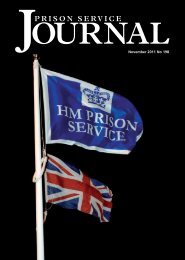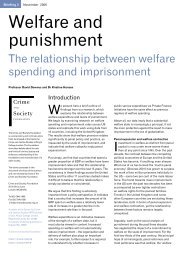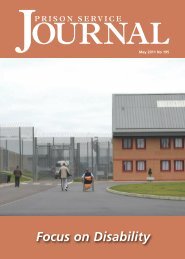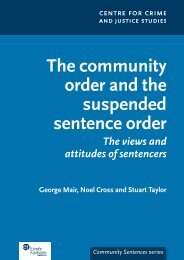PRISON SERVICE
PRISON SERVICE
PRISON SERVICE
- No tags were found...
You also want an ePaper? Increase the reach of your titles
YUMPU automatically turns print PDFs into web optimized ePapers that Google loves.
Crime-Pics IICrime-Pics II is designed to measure changes inoffenders’ attitudes to offending. It is administeredbefore and after participation in the ADTP in order toevaluate the extent of the programme’s impact on‘dysfunctional or anti-social attitudes, cognitions andbeliefs related to re-offending,’ ‘strong ties to andidentification with, anti-social/criminal models,’ ‘weakties to, and lack of identification with, pro-social/anticriminalmodels’ and ‘weak commitment to avoidingre-offending.’ Positive changes in these factors areexpected to be reflected in participants’ scores on thispsychometric measure.Limitations of Psychometric AssessmentsThe psychometric assessments detailed above donot measure all of the factors targeted by theprogramme (it does not include, for example, a measureof ‘social support systems for tackling drug/alcohol use’).Despite their limitations, these psychometric assessmentshave been selected based on their quality and establishedusefulness as indicators of change in factors which areinevitably difficult to quantify. It is thus possible toconclude that ‘positive’ changes in participants’ scoreswould suggestive that the ADTP has a positive impact onseveral of the key factors it targets.Participant Feedback and Focal Counsellor AssessmentsAs a twelve-step organisation with more than 50per cent of staff in recovery from addiction, RAPt hasalways recognised the importance of programmeparticipants’ perspectives. Whether they are de-selected,choose to leave treatment or graduate, all participantsare asked to complete a Participant FeedbackQuestionnaire. These ask participants to rate variousaspects of treatment and their subjective perceptions ofpersonal change using a five-point Likert Scale.Participant feedback forms are administered ontreatment completion. Participants who are de-selectedare also asked, but not compelled, to complete theforms.ResultsDemographic ProfileThe mean age for all participants was 29.2 (Min:21, Max 55). The ethnic mix on the programme and theethnic mix of the prison was undertaken and indicatedthat the programme participants reflected well theethnic mix of the prison and that no ethic group wasunder-represented. Participants’ age and ethnicity werenot related to treatment completion.Offending ProfileHalf of ADTP participants’ current main offenceswere violent offences (murder, violence, violentrobbery). A further 27.7 per cent had committedacquisitive main offences (robbery, theft, fraud orburglary). 14.3 per cent were serving sentences fordrug-related offences and the remaining 8 per cent forother crimes.Alcohol DependenceADTP participants are assessed against the sevencore DSM-IV-TR criteria for alcohol dependence. Thosewho do not meet any criteria are not considereddependent and are therefore not eligible for theprogramme. Those meeting 1-3* criteria are consideredto have low level dependence; those who meet 4-5*criteria are considered to have a medium level ofdependence and those who meet 6-7* criteria areconsidered highly dependent (and by necessity meet atleast one criteria of physical dependence). Theprogramme is intended for those with medium to highlevels of dependence.61.2 per cent of participants were highlydependent. 29.8 per cent of participants had a mediumlevel of alcohol dependence. Just 9 per cent ofparticipants had only low level dependence.Participants reported an average of 8.7 years ofproblematic alcohol use prior to treatmentMental Health ScreenParticipants on the ADTP reported high rates ofinsomnia, self-harm and past suicide attempts.Graduates and deselected participants were equally aslikely to have self harmed (24.3 per cent of graduates,24.0 per cent of deselected participants).Over 50 per cent of participants had been treatedfor a mental health disorder prior to engagement withthe programme, the most frequently reported disorderwas Depression followed by Anxiety and Panic Attacks.Results:Pre- and Post-PsychometricQuestionnaire ResultsAlcohol Taking Confidence Questionnaire (ATCQ)Participants’ confidence in their abilities to remainsober across high-risk situations was measured with theAlcohol Taking Confidence Questionnaire (ATCQ). TheATCQ is a psychometric measure of self-efficacy withregard to alcohol use.Improvements in ATCQ scores after treatmentGraduates’ mean ATCQ scores increased from 50.3per cent pre-treatment to 76.0 per cent post-treatment.This increase is highly significant and indicated thatparticipants who engage with the programme are moreconfident in their ability to remain sober post-treatmentInterestingly, 12.1 per cent of graduates showedreductions in confidence; the majority of these12 Prison Service JournalIssue 192











